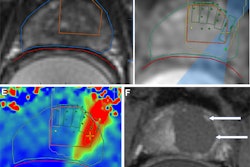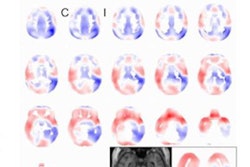
Applying treatments of MR-guided focused ultrasound to the brain can be an effective therapy for people with essential tremor, as well as tremor related to Parkinson's disease, according to a study to be presented at RSNA 2019 in Chicago.
Researchers from Italy applied MR-guided focused ultrasound (MRgFUS) thalamotomy to a group of 39 patients who had disabling tremors and who had not yet responded to treatment. The procedure involves using MRI to guide focused beams of ultrasound energy to heat and destroy a small part of the thalamus in the brain, the ventral intermediate nucleus. It is hoped that the procedure will provide relief from tremors on the opposite side of the body.
The average age of the patients in the Italian study was 64.5, and there were 18 individuals with essential tremor and 21 with Parkinson's disease, according to a group led by Dr. Federico Bruno of the University of L'Aquila in Italy. The procedures were performed with a commercially available focused ultrasound system (ExAblate Neuro, Insightec) under guidance of a 3-tesla MRI scanner (GE Healthcare).
Patient response to treatment was measured by calculating fractional anisotropy and apparent diffusion coefficient (ADC) values in the ventral intermediate nucleus. Bruno et al also evaluated patients for the severity of their tremors (using the Fahn-Tolosa-Marin scale) and their quality of life before MRgFUS thalamotomy, immediately after treatment, and over the course of the following year.
In all, 95% of the patients, or 37 out of 39, experienced substantial and immediate reduction of their tremors -- reductions that continued in follow-up evaluations. Changes in fractional anisotropy and ADC values were statistically significant, but only changes in fractional anisotropy values correlated with clinical changes under the Fahn-Tolosa-Marin scale. The patients also showed improvement in quality of life in both the essential and Parkinson's tremor groups.
One notable aspect of the study was the high number of patients with Parkinson's disease compared with previous studies, which mostly focused on patients with essential tremor.
MRgFUS thalamotomy is currently only available at a limited number of sites around the world and was only approved for neurological use three years ago, according to Bruno in a statement released by RSNA. But the technique could become more available as more positive research findings are published.
"Few patients know of this treatment option so far, and there are not many specialized centers equipped with the required technology," Bruno said.
Future research could involve treating both sides of the thalamus rather than just one. Studies are also investigating the use of MRgFUS in areas outside of movement disorders, such as for neuropathic pain, epilepsy, and obsessive-compulsive disorders.
The group's study will be the subject of a scientific paper presentation in room S401CD at 11:50 a.m. on Wednesday during RSNA week, as well as a "how we do it" digital education exhibit in the NR Community in the Learning Center Digital Education Exhibit.



















